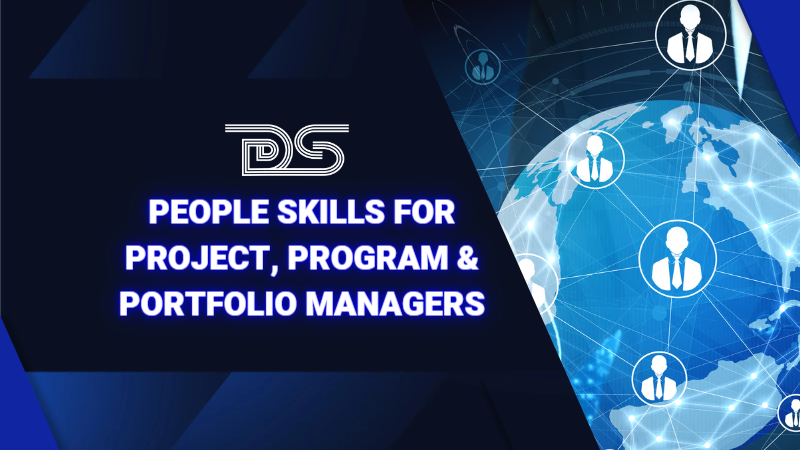
by DharamCW | Apr 21, 2023 | General
What makes a successful Project/Program/Portfolio Manager? Is it the number of years of experience? Technical know-how? Or the one who is good at managing people?
Creating objectives, critical path analysis, work breakdown structures, resource scheduling, and risk management are just a few of the technical areas of project management that project managers usually get training in. However, understanding pertinent people and management issues is important to a project’s success. In addition, a project manager must also continually deal with clients and other stakeholders. As a result, project managers’ people skills, also known as soft skills, are becoming increasingly important.
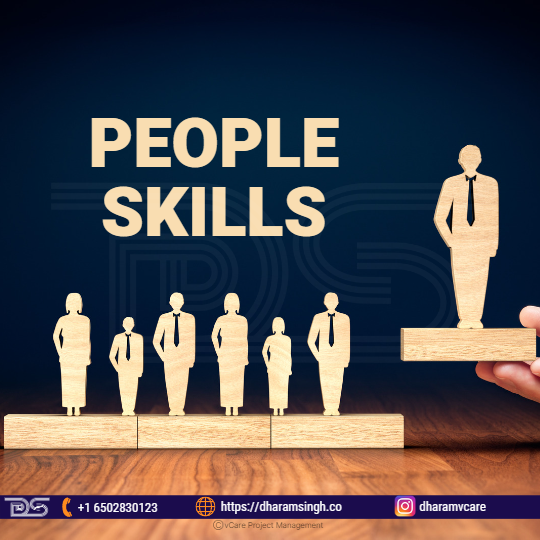
People Skills
People skills
People skills are linked with behavioral patterns or behavioral interactions that assist one in communicating effectively with people. Project leaders with strong people skills may favorably influence others, socialize effortlessly, and overcome public anxiety.
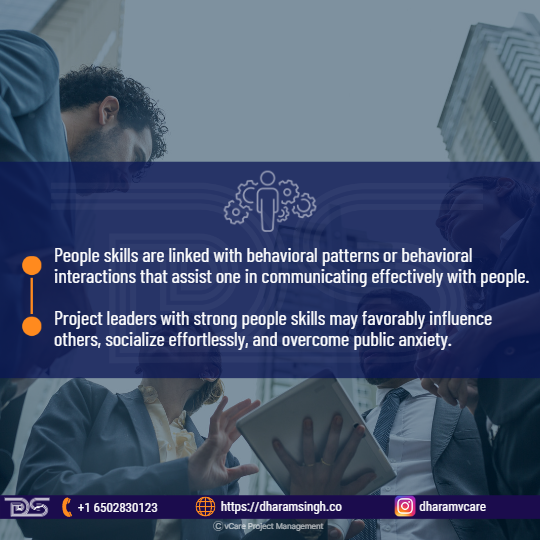
Project Leaders With Strong People Skills
They are transferrable social abilities that allow one to collaborate well with others. The three main types are personal, interaction, and interpersonal skills. These categories achieve the same overall objective: making the working connections with others mutually satisfying, pleasant, and productive.
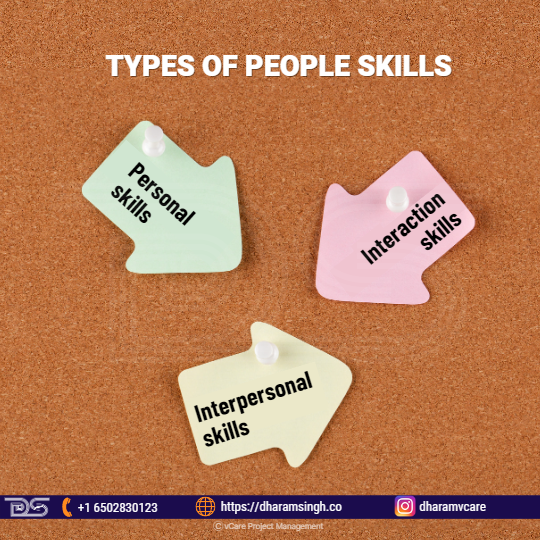
Types Of People Skills
Types of People Skills
- Personal skills: These include the capacity to communicate your skills and exhibit yourself to others successfully. It comprises characteristics such as self-assurance, honesty, and aggressiveness. Furthermore, one must be able to recognize their limitations and make sound judgments based on logic rather than emotion.
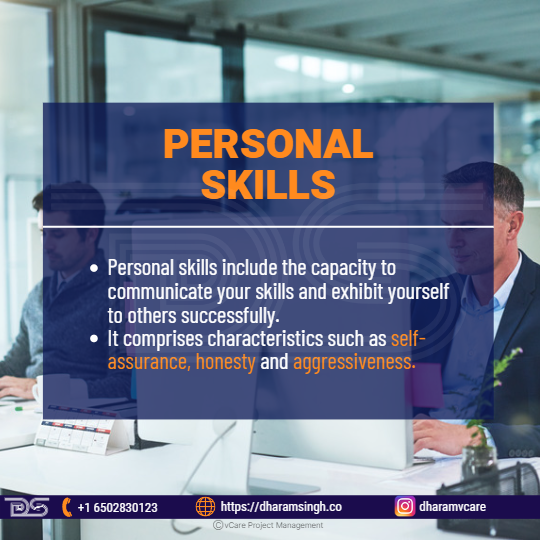
Personal Skills
- Interaction skills: It is essential for understanding the behavior and ideas of others while preserving limits and creating connections. A project manager, for example, should have social etiquettes that need empathy and listening skills to know that you have listened to them and given respect for their limits and requirements to connect with co-workers and clients productively.
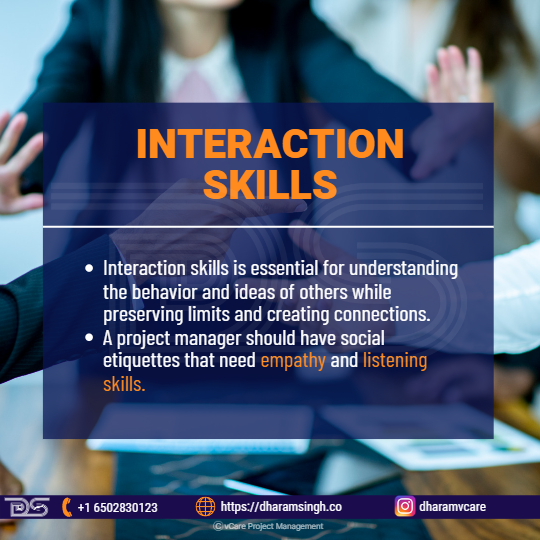
Interaction Skills
- Interpersonal skills: These are related to intercession skills, but they apply mainly to situations in which the persons involved have opposing interests or viewpoints.
Contrary to popular belief, people skills are not subjective concepts. On the contrary, these skills are critical, particularly in the project management role, which is largely concerned with people.
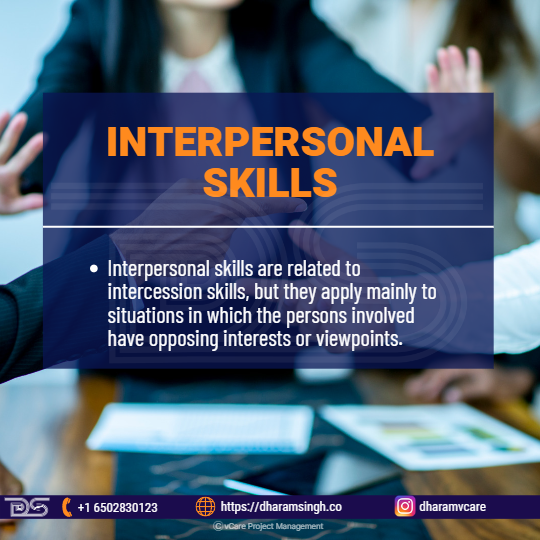
Interpersonal Skills
Project management is more than just completing the project; it is also about how you lead and assist your team. Leading others and leading them through the whole project lifecycle entails a certain amount of responsibility and necessitates certain abilities.
Furthermore, as work evolves, businesses embrace a varied workforce. As a result, people skills are essential for embracing tolerance and diversity. In short, good project management is based on human communication and connection.
Essential People Skills for Project/Program/Portfolio Managers
A successful project professional must possess a wide range of skills. Those that come to mind first are the technical skills required to create a project plan, schedule, budget, and all relevant paperwork. One must also have the conceptual skills to “see” the project as it develops.
However, such talents will only assure project success if the project manager can supplement their technical skills with a wide range of interpersonal skills or people skills. Here are some of the essential people skills for Project/Program/Portfolio Managers:
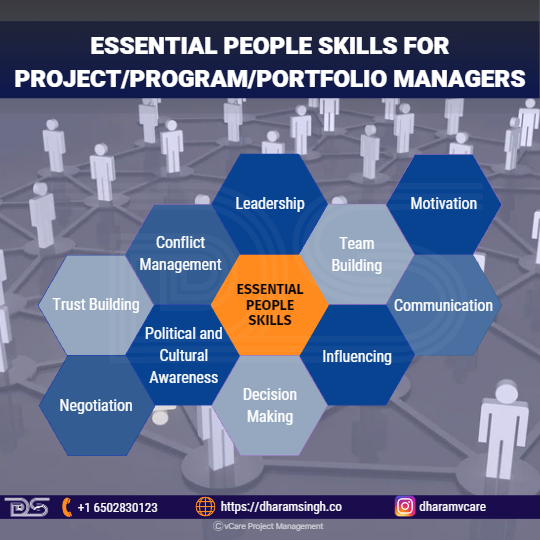
Essential People Skills for Project/Program/Portfolio Managers
- Leadership
One of the crucial skills a successful project manager has to have is leadership. This skill is essential because the project manager frequently has little control over the team members involved. This aspect calls for leadership on their part to handle the project. Although managing via leadership rather than authority might be more challenging, it is typically more effective since it is based on respect and trust.
At the start of a project, a leader must establish their vision and express it to the team. It makes supporting the project’s objectives easier for everyone on the team. Effective leadership will also keep the team members inspired and motivated to perform at their highest level.
- Team Building
Another vital skill for a competent project manager is team building. Because of the nature of projects, personnel from diverse departments are engaged. Most employees might have never worked together and may not even be familiar with one other’s departments. If the project manager can unite these individuals into a cohesive team with the same goal, the project may stay within its objectives.
Although some of the project’s individuals or sub-teams may execute their jobs individually, they must feel like they are part of the overall team. When choosing their part of the project, they must consider what is best for the project, not simply what is best for them and their departmental problem. A sense of belonging to a team that solves an issue for the entire company (rather than playing departmental favoritism) may go a long way.
Creating a team in which each member feels comfortable reaching out to the others will also guarantee that minor problems do not escalate into major concerns later in the project. It is consequently critical that project managers not only understand the duties and procedures involved in team building but also have the skill and finesse to apply them correctly.
- Motivation
If you want your project to succeed, you should concentrate on improving your motivating skills. Having these qualities will assist your project team members to stay interested in the project, strive for excellence, and work toward a common objective.
Good motivating skills will enable a project leader to create an environment where team members can fulfill project objectives while being satisfied with their work.
- Communication
Most professions require excellent communication skills. Some project managers believe the communication part of project management to be their primary job obligation.
Excellent communication skills are essential for building relationships among project team members, establishing trust, and keeping everyone motivated and on track.
A project involves several stakeholders informed of its status, timeframes, progress, risks, and concerns. A skilled project leader must convey all of these facts to project stakeholders on time and in the manner they anticipate. Project managers must also interact effectively with top management within their business.
Giving the interested stakeholders too much or not enough information might prevent the project from reaching its full potential.
- Influencing
It is critical to be able to influence people if you want to be a successful project manager. But what is important is understanding when and how to utilize such skills and avoid becoming a manipulator. There is a narrow path to follow.
A project manager’s responsibility is to bring employees from disparate departments together and get them to work together toward a similar objective. Sometimes, getting these diverse people to comprehend and agree on the specifics of achieving that goal might not be easy. A skilled project leader will utilize their skills to persuade others and assist them in reaching an agreement.
So, think about your relationship and influence over people not just for the time of the project but also for how things will proceed long after the project is complete. After the project, customers and end-users will utilize the goods, deliverables, and outcomes developed by the project. A powerful and positive effect creates a trusting atmosphere among all team members during and even after the project.
- Decision Making
A successful project manager must acquire various talents, one of which is decision-making skills. There are four primary decision-making styles: Directive, Analytical, Conceptual, and Behavioral. Project managers should be conversant with all four since either has to be leveraged at some time. In addition, consultation, consensus, command, and random styles are provided.
Having a decision-making model will facilitate this process. In addition, since so many people who may disagree with a decision are involved in the project, having a process to follow can be very helpful in gaining consensus with the group.
- Political and Cultural Awareness
In today’s world, project managers work in a more globalized context than in the past. As a result, cultural diversity is another critical component of effectively navigating the corporate world as a project leader. A successful project manager must be able to notice and comprehend cultural differences and incorporate them into the project plan.
Cultural differences can impact decision-making and the pace with which work is performed. It can also lead to members acting without sufficient forethought. Recognizing cultural differences can lead to conflict and stress within the project, further delaying it.
Furthermore, it is critical to understand the politics at work in the project environment. The use of political skills can greatly aid a project manager’s success. More significantly, failing to recognize the politics involved can lead to substantial challenges and impediments that can cause a project to be delayed or even destroyed.
- Negotiation
The nature of a project manager’s work necessitates being skilled negotiators. Typically, several stakeholders are involved in the project, and most projects include team members from many departments. This aspect frequently leads to a variety of points of view, which can make it challenging to keep the project on track and within the intended scope.
Negotiation skills can assist a project manager in obtaining an agreement or making a compromise on an issue that may be causing difficulty or delay.
There are several negotiation skills that the project leader should be able to employ. These include assessing each scenario, being an engaged listener, and communicating coherently throughout the dialogue. It can be important to distinguish between the wants and requirements of the people concerned. Another critical focus is recognizing the distinction between people’s perspectives and their interests and concerns directly relevant to the project.
- Trust Building
When collaborating on a project, trust is really valuable. A trusting environment promotes effective relationships and communication among team members and stakeholders. Therefore, a project leader wants to foster an atmosphere of mutual trust. This trust helps to maintain morale, keep conflict at a minimum, and keep everyone working effectively together.
If you were working on a project, you would want everyone participating and working hard to see it through to completion. When you work hard, you expect that others are also working hard to achieve the project objectives. The team leader wants to trust a team member who suggests they can execute a task properly and on time. If someone in the team wants assistance, they want a team that will support and collaborate to achieve the work. So don’t waste time second-guessing someone who isn’t telling the truth or has bad motives.
There are several approaches for a project manager to establish trust. First, a project leader must be a great and open communicator to reduce misunderstandings and build confidence among team members. Often, one may have to put their self-interests aside for the team’s sake and must model and display the behavior they demand from others.
- Conflict Management
On a project, conflict is almost unavoidable. Members of the project team and stakeholders may have differing perspectives, areas of expertise, interests, personalities, work styles, and so on. When one adds additional factors to the mix, such as tight deadlines, resource limits, and communication challenges, it’s easy to understand how conflict might arise.
Conflict often leads to a better solution to a problem. For example, if a team member would prefer to agree or accept the status quo, then risk causing conflict by pointing out a problem, asking a question, or suggesting an improvement. In that case, it is simpler to accept a suboptimal solution. However, disagreement frequently stops the team from working successfully together and diverts attention away from the duties at hand.
The goal is to prevent conflict or its escalation or to know how to regulate or lessen it when it arises if they cannot avoid it. For example, a project manager may use several tactics or methods when dealing with a dispute. They can be aggressive, accommodating, avoiding, or compromising. Some approaches work better in particular situations than others.
The project manager and team members involved in the conflict influence the team’s efficacy. A project manager can also utilize many approaches; if one fails, they may have to try another to see if it is more successful.
Why are people skills important?
People skills are crucial because it is much more difficult for people in an organization to work together to achieve common goals if they fail to express themselves or understand how their co-workers feel about a certain project, task, or difficulty.
As a result, the organization’s production and profitability suffer while creativity and innovation endure. People skills, in particular, may assist us in the following:
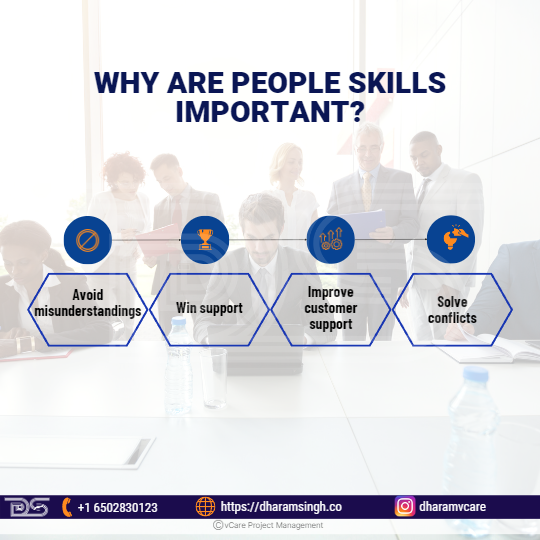
Why Are People Skills Important?
- Avoid misunderstandings: People are less likely to misinterpret what you’re saying if you communicate ideas and instructions.
- Win support: If you can communicate effectively and understand what your team wants to hear, it will be much simpler to persuade them and get them “on board.”
- Improve customer support: You’ll be better positioned to fix their difficulties if you can get inside their minds and comprehend their key problems.
- Solve conflicts: Conflict isn’t always unpleasant, but if it goes unresolved, it can harm morale and productivity. Strong people skills allow us to see things from a new perspective and identify similarities, which reduces the likelihood of significant conflicts.
How to develop people skills?
Even while people skills are critical, they are frequently undervalued by employers when it comes to job advancement. Internal training sessions are frequently centered on teaching hard skills, such as completing a given activity or utilizing a specific piece of software. These methods make it more difficult for professionals to build their interpersonal skills.
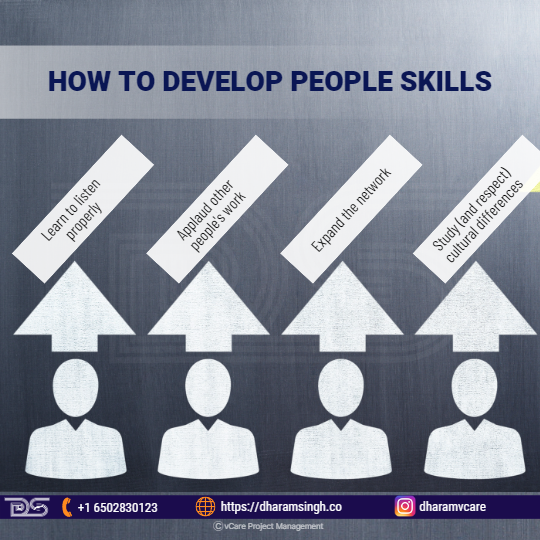
How To Develop People Skills?
But just because something is more difficult does not make it impossible. Here are four suggestions for improving people skills and becoming a more attractive prospect are:
- Learn to listen properly
- Applaud other people’s work
- Expand the network
- Study (and respect) cultural differences
Final Thoughts
Effective project management is challenging but having people skills may help project leaders run projects more efficiently and with less stress. Furthermore, it enables building a team that can handle the most challenging tasks and is more successful and resilient during difficult times.
People skills, on their own, will not keep a project team motivated and engaged. However, arming oneself with the necessary technical skills and intelligent tools may dramatically enhance the workflow and contribute to the project’s success.
Feel free to check out my discussion on this topic with Thomas Walenta in YouTube
For any questions related to your Project Management career, training, and certifications, you can book an obligation free 15 minutes session with me by visiting http://talktodharam.com/
You can subscribe to the vCare Project Management YouTube Channel to catch future videos of our Q&A series and certification success stories: https://bit.ly/2YF0wJl
You can subscribe to and follow my podcasts and interviews with Project Management Experts on YouTube at https://bit.ly/2NDY8wd
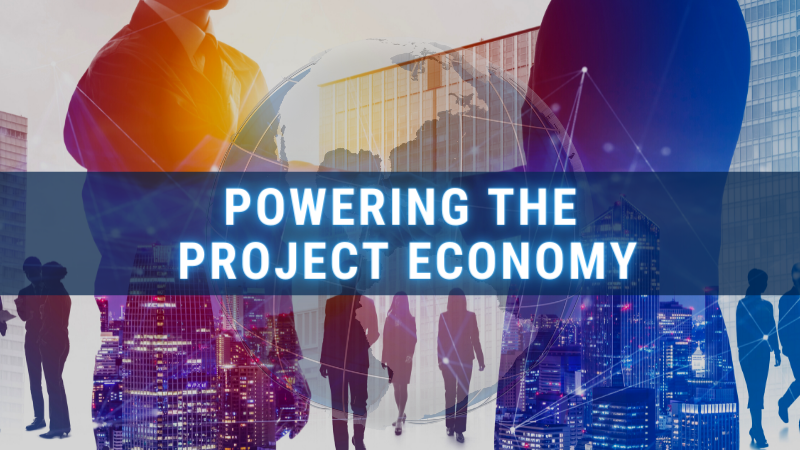
by DharamCW | May 20, 2022 | Project-Program-Portfolio Management Knowledge
Ideas into Reality
People have the skills to work on projects, but they need to be channelized across multiple projects. These skills are the ones that help in the success of the projects. In the end, the people’s skills and capabilities in the project serve to turn ideas into reality. That is when the project delivers value to its stakeholders. The people are the enablers for the growth and transformation of the projects. Ideas can be converted into reality by achieving the right mix of skills and capabilities in people.
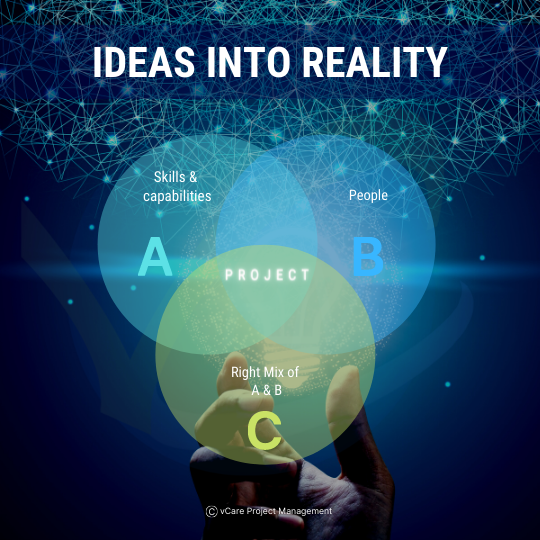
Ideas into Reality
The Project Economy at Work
The skills are utilized in project-based structures included in large organization’s portfolios and programs.
According to Professor and author Roger Martin, one of the world’s top-ranked management thinkers, this kind of approach is called “projectization,” where the everyday tasks become projects by themselves. Such trends are on the rise as “Gig Economy” is part of the project economy, which has been largely adopted by organizations like Ola, Uber, Airbnb, etc.,
People with varied skills, experience, and capabilities are brought onto one project to deliver value to the stakeholders. The resources are aligned at the portfolio level and mobilized to the projects on-demand based on priorities. Such an approach minimizes the cost of hiring, training, and retention. They all evolve into a high-performing workforce as they started merging into the socio-cultural aspects of the portfolio capabilities.
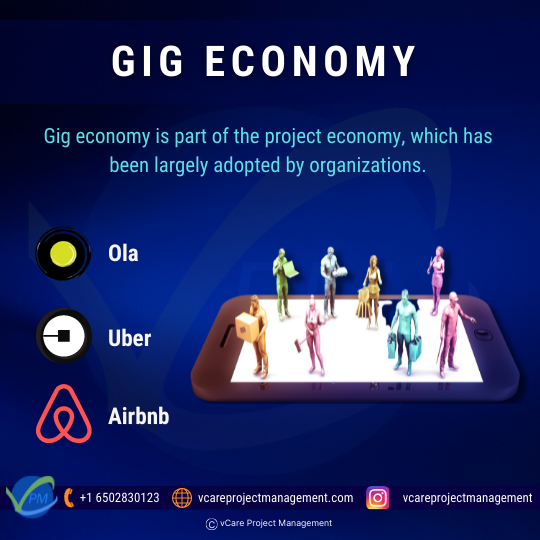
GIG ECONOMY
For example, companies like Zappos adopt a culture wherein the onboarded people or hired people are put onto their call centers to understand the various departments involved in the process and understand the pain they undergo. Post that, they will be able to get the context and core values of the organization, which were they can synchronize. It’s all about the task at hand than the title itself.
Vital skills in Project Economy
The Project Economy needs uniquely human skills such as leadership, creativity, and empathy.
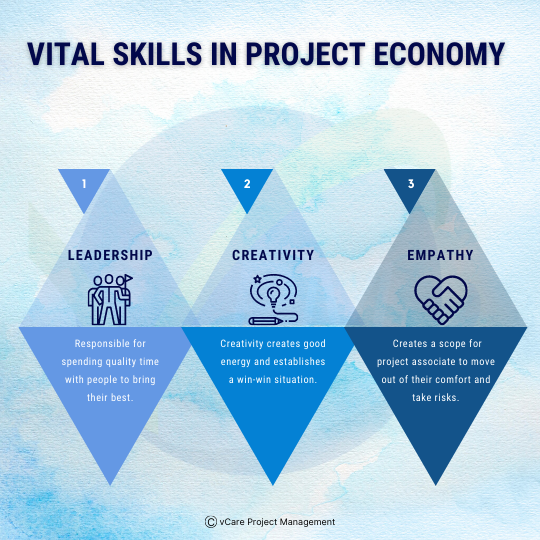
Vital skills in Project Economy
Leadership – Need to bring in the best of human potential. When the project economy is adopted, the people will move from role-based work to project-based work. As projects are going complex, a project manager is responsible for spending quality time with the people to bring their best.
Creativity – Creativity helps to find solutions to the problem in novel ways. Co-creation along with the stakeholders would minimize the postponement of decisions. It also extracts the thinking power of the participants creating new options. Creativity also creates good energy and establishes a win-win situation. Creativity can be fostered by providing an appropriate space to the team, decluttering the workplace, adopting a design thinking approach, etc… Foster an environment where creativity is recognized and rewarded
Empathy– When the project manager applies empathy, it creates scope for project associates to move out of their comfort zone and takes risks. It also brings on agility and helps reduces stress through minimized conflict. With empathy kindness and compassion becomes the natural ingredient promoting teamwork and leadership among individuals. Empathy can be exhibited by the project manager who is willing to be vulnerable and has the mindset to listen to all and exhibit leadership by walking the talk.
Project Economy Adoption
In the Middle East
There are many infrastructure projects already underway in the Middle East, such as Smart City, Higher Education, expansion of health care, etc… These projects bring changes to the digital infrastructure, transportation, and allied government service. Already in Dubai International Project Management Forum plays a vital role in megaprojects, including Construction of Digital Twin, Asset Project Management, BIM Implementation for Roads and Transportation Authority, Solar Park. All of these projects need people to execute. People are needed with the right skills to provide value to the stakeholders.
In the European Union
Case Study-1: Municipality located in Southern part of Sweden with more than 32000 inhabitants having organization size of 2400 full time and permanent employees have been organized as seven administrative departments. EU-funded projects were executed, and the projectification of departments, including public health, was achieved.
- The municipality has educated themselves and other organizations surrounding them, which helped effectively manage the EU funds and create competent project organization where employees make sense of their work.
- This move is transforming the civil servants, politicians to handle project activities affecting their organizing the style and overall impact on their performance routine.
- Implies changes where routines, or day-to-day activities, to an increasing extent are organized and understood, as if they were projects.
Case Study-2: Totally program worth 67.9 billion was allocated for the operational program through the EU. Territorial Self Government Units covering 57 offices were involved in a Survey related to identifying the benefits of Projectification
- Labor market institutions, up to 100% of offices declared that projects are never abandoned in the course of their lifetime
- In 96% of the projects, there was no change in the planned budget
- 89% of projects were completed according to the original schedule
- In 96% of the projects, there was no change in the planned budget
- Public organizations acting in this way make use of opportunities that arise in their environment, which proves their flexibility in adapting to changing conditions
- Changes in organizational structure are a temporary adaptation to the changes that have occurred in the external environment
Case Study-3: Automotive, Manufacturing, Engineering-Procurement-Construction (EPC), 2006 Football World Cup, Establishment of the Tsunami Early Warning System in South-East Asia.
- GPM study on projectification in Germany, almost 50% of working time in the manufacturing industry is spent on project work (GPM 2015)
- The project economy will generate 15% of value-added in Germany in 2020 (in 2007, it was 2%).
- The mean value shows that around 37% of all work processes in corporations are now organized in a project-oriented manner.
Summary:
As priorities change in these difficult times rapidly, project organizations need to embrace change. The Project Management office needs to build a team that commits to success. Project economy adoption is already a reality in various regions of the world. There are proven cases wherein successful projects are delivering values. Let’s focus on turning ideas into reality.
Feel free to check out my discussion on this topic with Dr. Reinhard Wagner in YouTube
You can subscribe and follow my podcasts and interviews with Project Management Experts on YouTube at https://bit.ly/2NDY8wd
You can subscribe to vCare Project Management YouTube Channel to catch future videos of our certification Q&A series and student success stories using the link https://bit.ly/2YF0wJl
For any questions related to Project Management career, training, and certifications, you can book an obligation free 15 minutes session with me by visiting talktodharam.com
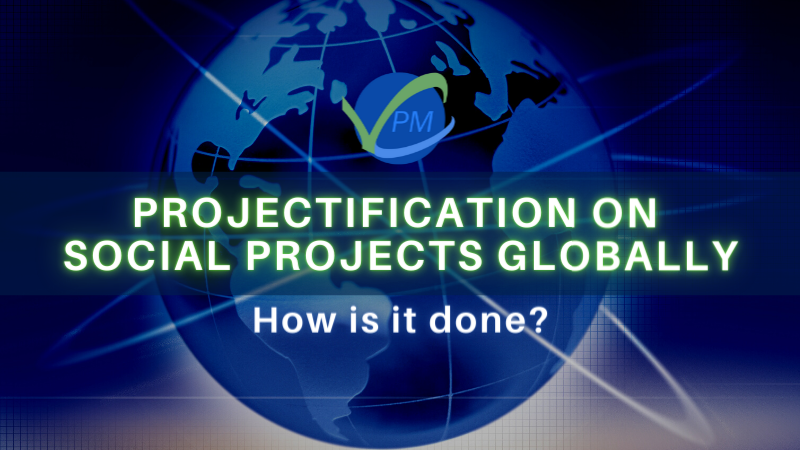
by DharamCW | Apr 26, 2022 | Project-Program-Portfolio Management Knowledge
- Implementing public policies through projects is driven through global organizations such as World Bank, UNICEF, UN, etc., encouraging projectification practices that drive down activities vertically deep down.
- Implementation and deployment of public policies are time-framed. Hence, they are projectified.
- Projectification is seen as a key strategic measure for getting things done concerning the EU.
- OpenPM² is a project management methodology designed by the European Commission for interoperability solutions for public administrations, businesses, and citizens.
- We introduce projects to the public sector managers’ toolkit in the smallest offices and teach how to build project portfolios in the largest public units.
- The Polish public sector used the external funds and started to fully “think project-wise.” Because projectification of activities was a “sine qua non” condition, none of the countries joining the EU structures can fully integrate with them if there are no competencies regarding project management.
- To receive and implement a project, people have to organize themselves into teams – so projects build micro-communities and unite people around a common goal, often involving stakeholders who have so far been excluded.
Models such as GPM3 can help manage the implementation and evaluation of projectification efforts and their maturity, as given in the figure below.
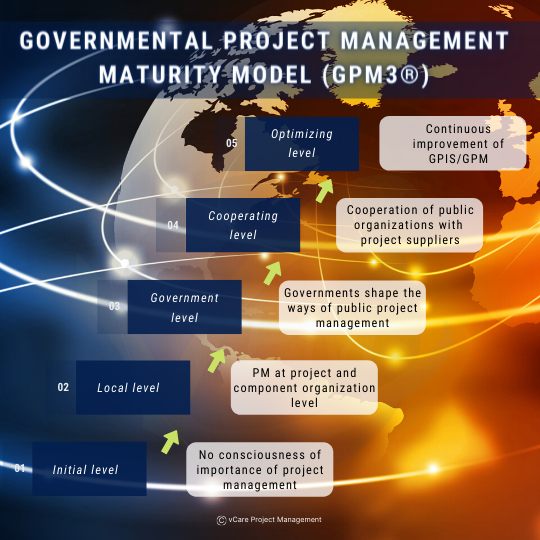
Governmental Project Management Maturity Model (GPM3®)
Governmental Project Management Maturity Model (GPM3®)
A maturity model is the sequence of groups (levels) of more efficient practices in any activity area. Our base area for defining maturity levels are Governmental Project Implementation and Governmental Project Management treated together as one system. The first source of our inspiration was Capability Maturity Model Integrated (CMMI ©) – probably the first widely recognized and probably best-known maturity model. The second source of inspiration was the Organizational Project Management Maturity Model (OPM3©) – a maturity model for the organizational level.
Initial Level
Some governments are (really!) not interested in managing their projects and investments. They think it is enough to allocate the budget and set the deadline for product delivery, and people will know how to do it. We say about such governments that they are at the lowest, Initial level of project management maturity.
Local Level
At some moment, people in individual governmental agencies and organizations, worried about continuous failures of their projects and inefficient work, learn that efficient and effective project management methods exist. After some time, they manage to convince their organization executives that it is worth implementing them throughout the organization. If project management methods are implemented only in some governmental organizations, we say that the given government has reached the Local level of project management maturity.
Governmental Level
After some time, the cabinet learns that a few of its projects (either internal or foreign governments) were implemented more efficiently than anywhere else. This awareness resulted in implementing project management methods, techniques, and processes to work in all government projects. This way, project management maturity in that state reaches the Governmental level.
Cooperating Level
But should the government only define the ways of project implementation and passively observe the results of these processes? It is better if the government is actively involved in implementing projects, like trying to solve problems faced by – usually complex and complicated – government projects. Then we say that governmental project management has reached the Cooperating level.
Optimizing Level
But this is not the end of the journey to the top of the ladder of maturity. Everything can always be done better (if there is such a need). The most advanced governments – such as the US Federal Government – command its ministries and agencies to improve project (and program) management processes constantly. Then we say that the given government has reached the Optimizing level of project management maturity. And this description of progressively achieved levels of project management maturity (which can be observed in some countries) is called the Government Project Management Maturity Model (GPM3®).

Think global, Act local
Think global Act local: Committed project management individuals are experts at acquiring funding and coordinating support for their solution. In terms of projectification, these characteristics of the project champion are skills that are disseminated and encouraged across local government organizations. These Project Managers need to have the skills to cut across culture, language and have the ability to influence the groups for projectification.
Involve in fieldwork to get closer
- Connect with the local people at the ground level and understand the ground situation better for such implementations.
- Observe in the meeting and participate in meetings based on the dynamics involved with civil servants in different departments.
- Be available at the field level to have empathy towards the problem in projectification.
The more you become closer to them, the better operational goodness.

Fieldwork
Projectifications impact on BaU (Business as Usual)
- Activities are organized and realized as projects.
- Projects are the new form of work and mechanism for change.
- Enforcing the way of projectification through regulations, framework, and practices
- Projects in the public sector impact governance and help adopt previous best practices.
- Helps to identify and pilot a new way of work
- Helps developing new strategies and shaping the future for the society through innovation and joint learning, and
- In some cases, organizations might use projects for dealing with controversial issues that the permanent organization does not want to deal with.
Conclusion
In the global setting, Projectifications provide organizations with the ability to link multiple business partners and respond quickly to market demand and supplier needs while remaining flexible enough to anticipate and respond to rapid shifts in consumer preferences. The positive impact has been proven, so countries and its government need to enable the Civil Servants to become better project management and program management professionals for seamless projectification. This move would lead to a better economy, GDP and generate an extraordinary value stream across the government services.
Feel free to check out my discussion on this topic with Dr. Reinhard Wagner in YouTube
You can subscribe and follow my podcasts and interviews with Project Management Experts on YouTube at https://bit.ly/2NDY8wd
You can subscribe to vCare Project Management YouTube Channel to catch future videos of our certification Q&A series and student success stories using the link https://bit.ly/2YF0wJl
For any questions related to Project Management career, training, and certifications, you can book an obligation free 15 minutes session with me by visiting talktodharam.com
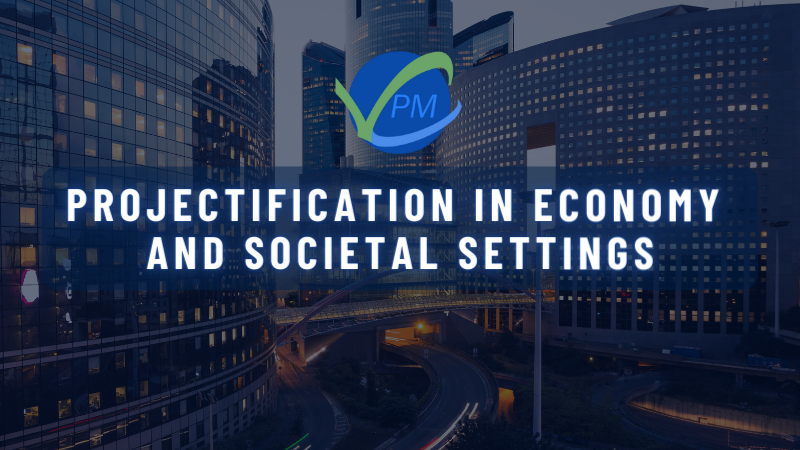
by DharamCW | Mar 29, 2022 | Project-Program-Portfolio Management Knowledge
In the public sector, as Mats Fred (2018, p. 189) indicates:
Projectification as proliferation emphasizes the increasing use and diffusion of projects and project ideas. Projectification as transformation and adaptation highlights the transformation of “permanent” ordinary organizational activities to temporary projects and processes of adaptation in the surrounding organizations and structures. Projectification as an organizational capacity building in which the project logic is spread and diffused in local government organizations, not primarily through specific projects, but through practices encouraging the project logic and reinforcing local government’s organizational project capacity.
The term “Project” itself would be considered as a temporary endeavor. Projectification involves the cultural and discursive societal processes whereby projects and project-like circumstances are institutionalized in individual lives, organizing all sorts of work and society. They are to be planned, controlled, managed with dedication and commitment. In a societal setting, it calls for flexible action and task-focused social relations.
Understanding the Societal Setting
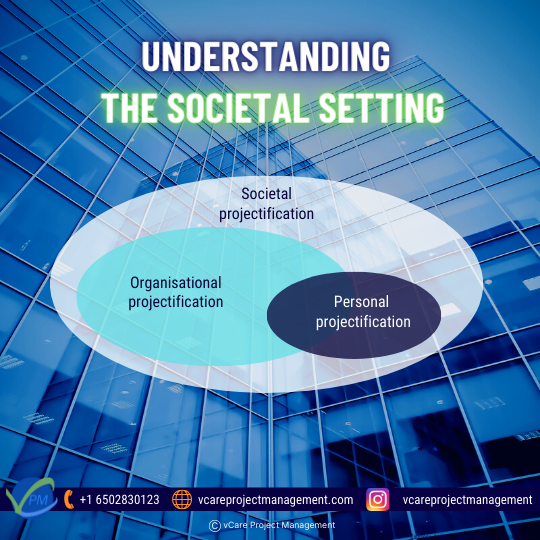
Understanding the Societal Setting
When the boundaries of the project go beyond the organization, societal settings come into place. Societal settings focus on developing and providing solutions together. When the projects are managed and executed at the societal level, it becomes a more collaborative effort. This kind of environment calls for global communication, collective intelligence, identifying skills across the board to leverage. Project execution should focus on accomplishing the tasks by adopting agile principles with empowering the team. The focus should be working through the community via effective networking.
Factors that could affect projectification in societal impact
There could be an influence at a Project Level, Political, Bureaucratic and Market Level. To a varying degree, local government involved in the societal settings would have specific practices that correspond to a political, bureaucratic, and market context. In terms of projectification, there could be complementary or contradictory aspects in nature that need to be managed well. Projectification translation could be done based out on specific settings and practices.
The societal context would have to manage multiple institutions yet need to bring them with a common goal and vision despite indifferences. This aspect needs to be dealt with using Decoupling, Compromising, and Combining depending on the situation and environment. These practices will de-escalate tensions in arriving at a consensus on the focus area or goals.
The project budget needs to be derived from the policies wherein the costs are derived from the social investment funds. This action would mean cutting across the government and local bodies in the region. Sometimes these funds are advocated by World Bank, EU, IMF, etc… Using such funds would also call for strong coordination among the various stakeholders across different processes and procedures. Managing such funds could be tiresome and painful.
Be in the realm of the project in the implementation context. It would look like a smooth sail as initiation would be easy on the ground implementation could be a posing challenge. Focus on the welfare benefits, lower costs for the larger group during the implementation. Understand the potential areas of resistance early in the project upon the various factors including economic, environmental, etc.,
Projectification involves managing an organization to manage two types of complexity involving task complexity and Social complexity. Task complexity refers to the density of the units, causal links, and consequences within a temporal and spatial frame. Social complexity describes the number of members communicating and working with each other and the differentiation of their tasks. In contrast, cultural complexity encompasses the number of different historical experiences and sense-making processes confronting each other in a project.
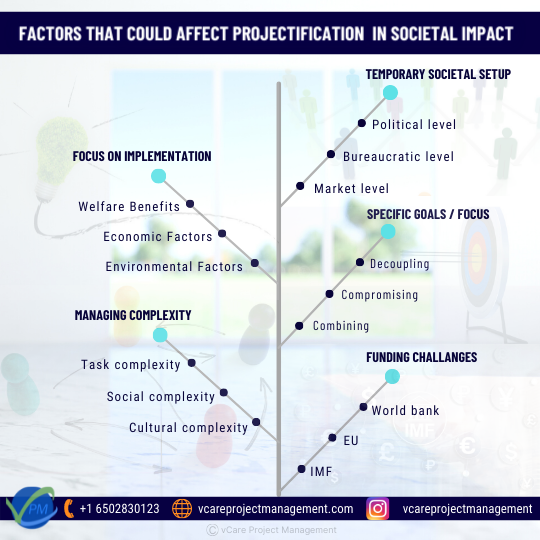
Factors that could affect projectification in societal impact
The three projectification studies in Germany, Norway, and Iceland show that project work contributes to one-third of the national gross domestic product. Although differences exist among the countries regarding size and industry structure, the degree of projectification of advanced economies seems to converge on around one-third of all economic activities. The exact results showed that the share of project work in Germany was 34,7% in 2013, and 32,6% in Norway, and 27,7% in Iceland in 2014 (Schoper et al., 2018).
The projectification in the public or governance societal segment was more towards improving, modernizing the managerial approach towards the commoner or public. The projects were part of the public sector in the infrastructure area, such as Road Construction, Dam Construction, construction, and larger institutions, and their Projectifications are not sudden. Based on one of the research study by Schuster in 2015, he identified three key factors which seem to provide public/civil service organizations to adopt projectification. They are:
- Quick Mobilization
- Strategic approach towards managing the change
- Accountability and Transparency to stakeholders
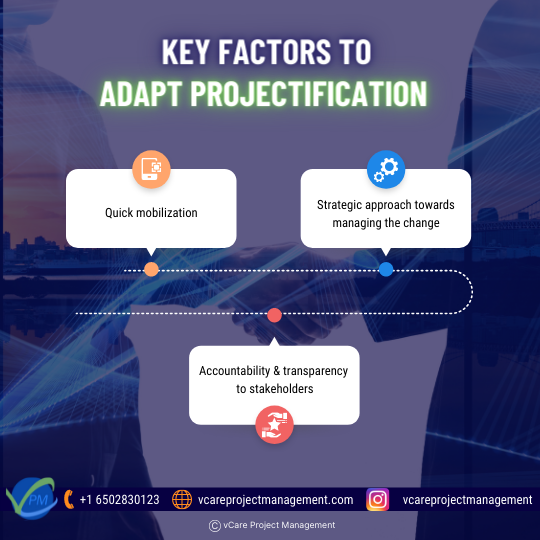
Key factors to adopt projectification
It is also to be realized that the ongoing social and economic change and the increase in public sector stakeholder’s innovation and entrepreneurship are most needed in this sector. Projectification helps to meet the void, which can help implement public policies, thus enabling changes in resolving social problems. Even though the benefits exist on projectification, it is not implemented due to the factors such as – Excess bureaucracy, Causes lack of trust, lack of persistence, etc.,
Conclusion
Projectification provides benefits to the people involved to know how to lead a team, influence people, and negotiate or resolve conflict. It would be a combination of more organizing activities to the organizations and transforming ordinary activities into projects. And increasingly, everybody needs to feel comfortable working in a digital environment.
Feel free to check out my discussion on this topic with Reinhard Wagner in YouTube
You can subscribe and follow my podcasts and interviews with Project Management Experts on YouTube at https://bit.ly/2NDY8wd
You can subscribe to vCare Project Management YouTube Channel to catch future videos of our certification Q&A series and student success stories using the link https://bit.ly/2YF0wJl
For any questions related to Project Management career, training, and certifications, you can book an obligation free 15 minutes session with me by visiting talktodharam.com
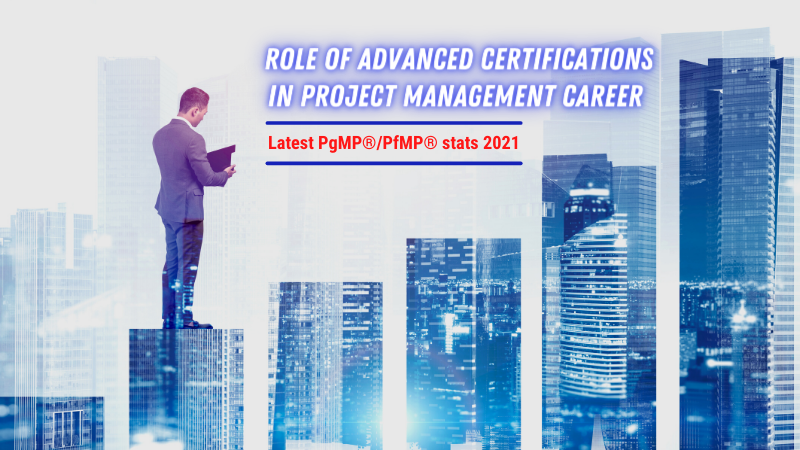
by DharamCW | Mar 19, 2021 | How many PgMP | How many PfMP
Most project management professionals with a certain number of years of experience would like to move up their career ladder to senior positions that provide them with higher visibility, wider recognition, and a definite bump in their pay scale. They would aim to become a
- PMO Leader of their organization
- A Program Manager handling multiple connected projects
- A Portfolio Manager who drives the vision and mission of an organization through successful programs and projects
- An executive who is implementing a strategic initiative for the success of the organization
Some professionals might be looking to migrate from their current organization to a better/higher position in another organization and might be wondering what could be one of the keys that open that door to success.
Advanced Certifications might be the solution.
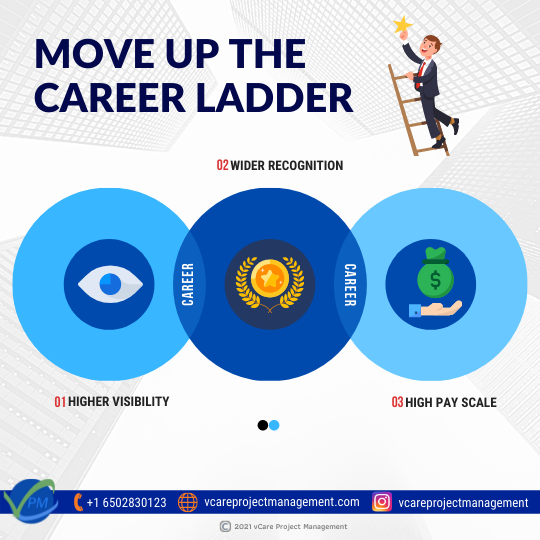
Move up the career ladder
Advanced Certifications
Advanced Certifications are for professionals,
- Who are established in their careers but want to climb up further
- Who want to increase their knowledge and improve professional ways of working
- Who are working in a role much more extensive than their current designation
- Who wants to prove a point to professionals in their space about their capabilities
- Who wants to prove a point to themselves for self-motivation and increase their self-worth
Advanced Certifications help you to,
- Change labels from being named an Experienced/Advanced professional to become an Expert/Master of the art.
- Change levels to elevate yourself to higher levels in the organizational hierarchy. Earn the birds-eye view.
- From “Doing the work right”, move to a phase where you start “Doing the right work” to ensure your organization’s mission and vision are accomplished through your actions. Go from Tactical to Strategic.
- It opens doors that were earlier closed in your career and creates new doors for you to venture. Gain global recognition. SKIP THE QUEUE IN PROFESSIONAL EVALUATIONS.
- Stand out from the crowd, Be that Differentiator.When all is Equal, the certified gets hired.
- Eliminate career shocks such as layoffs and retrenchments.

Advanced Certifications
Why PgMP® & PfMP®?
The PgMP® certification recognizes advanced experience, skill, and performance in overseeing multiple related projects and their resources aligned with an organizational objective. PgMP® certification holders oversee a program’s success — a way to group multiple related projects to achieve benefits that may not be realized if the projects were managed in a stand-alone fashion.
The PfMP® certification recognizes advanced experience, skill, and performance necessary to manage and align a portfolio of projects and programs to realize organizational strategy and objectives. PfMP® certification holders oversee one or more portfolios’ success, balance conflicting demands between programs and projects, and allocate resources based on corporate priorities and capacity. As portfolio management continues to grow and organizations adopt it to achieve strategic objectives, it becomes more critical to have individuals competent in this practice area. As employers demand portfolio managers who can support the organization’s strategic goals, PfMP® certification holders will gain a distinct advantage in employment and promotional opportunities over their peers.
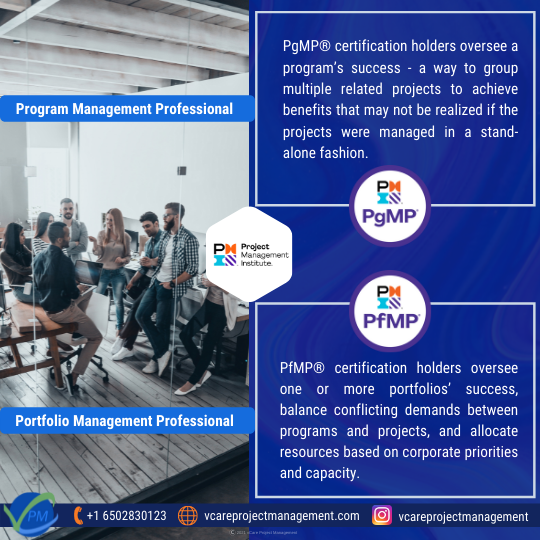
Why PgMP® & PfMP®
Both PgMP® & PfMP® from PMI could help you achieve the possible elevation within your organization or get you the golden ticket to join your targeted organization. Compared with the PMP, which is more than a million globally, the numbers for PgMP® and PfMP® are still in the four digits, with PfMP® crossing the 4-digit mark just a few months ago.
The Numbers – What do they say?
Irrespective of the Pandemic concerns, professionals have been pursuing their PgMP® & PfMP® goals aided by the online/remote learning program options. PgMP® has crossed the 3500 number barrier, and as on 1st March 2021, it is now at 3543. PfMP® has crossed the 1000 number milestone, and as on 1st March 2021, it is now at 1035.
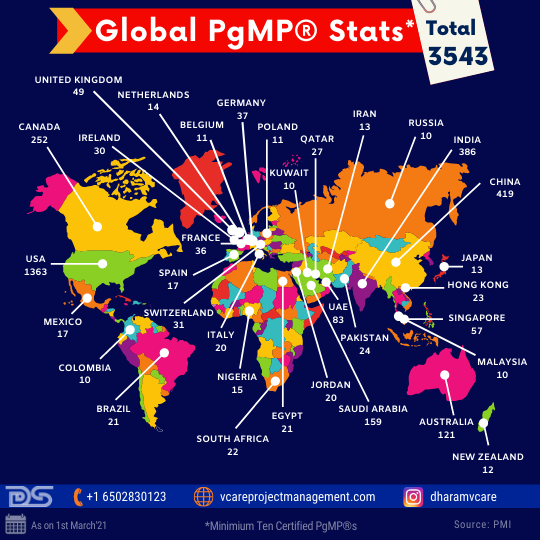
Global PgMP® Stats 2021
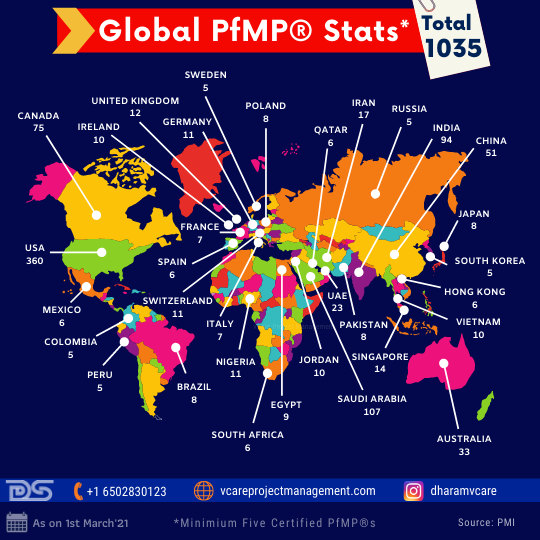
Global PfMP® Stats 2021
USA, China, India, Canada, and KSA contribute to the top 5 numbers in PgMP® and PfMP® numbers.
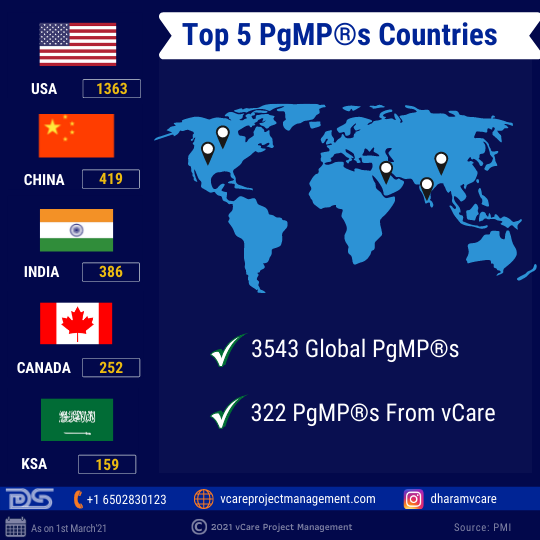
Top 5 PgMP® Countries
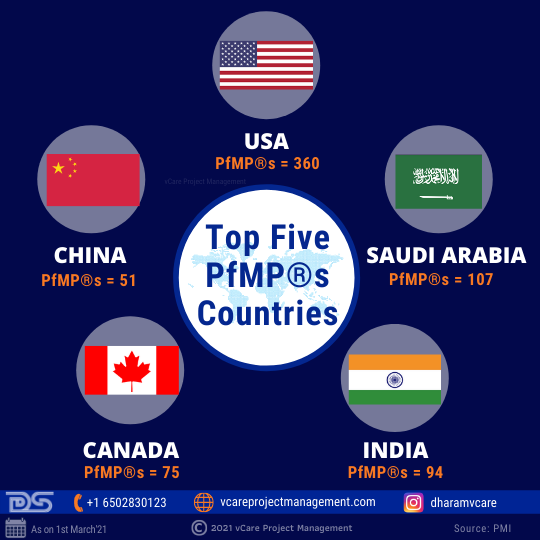
Top Five PfMP® Countries
A unique aspect in PfMP® numbers is the surge of certification holders from KSA, which has overtaken India to become the second country with the maximum number of PfMP® holders after the USA. With our training partnership with the PMI-KSA chapter, I wish the numbers of not only PfMP® but also that of PgMP® surge ahead. Students from KSA and the PMI-KSA chapter can reach out to me to avail offer associated with our partnership.
vCare Project Management is proud to have supported the following students in February 2021 in their successful pursuit of certification. This 2021, we have been producing excellent results with 10 PgMP®s and 6 PfMP®s achieving success in their certification goals aided by our training services thus far.
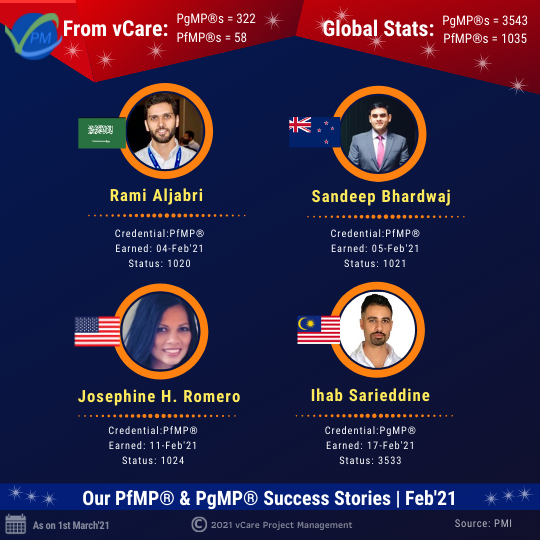
PfMP® & PgMP®s Success Stories | Feb’21
In the year 2020, we supported 48 PgMP®s and 16 PfMP®s in achieving success. As on 1st March 2021, we have thus far aided 322 PgMP®s of the 3543 PgMP® professionals and 58 PfMP®s of the 1035 PfMP® professionals. We have supported 322 students across 44 countries in their successful PgMP® journey.
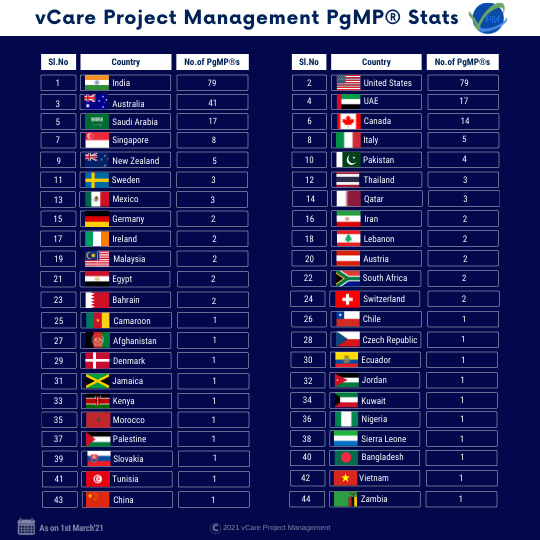
vCare Project Management PgMP® Stats
Because of the hardships that the companies and professionals are going through currently, I have decided to offer multiple discounts and flexible payment options to our upcoming mentoring and boot camp programs in 2021. These include,
- A 20% discount for Active Duty or Veteran professionals from Army, Marines, Navy, Air Force, Border, and Coast guards or any other valid military service branch
- A 20% discount for Women professionals
- A 20% discount for Differently abled professionals
- A 20% discount for professionals who are currently in dire financial constraints
Please email ([email protected]) or reach out to me on LinkedIn to avail of this discount post appropriate scrutiny.
Given below are the various online programs’ links. The online mentoring programs / virtual boot camps cover all time zones.
PgMP®: http://bit.ly/2oBKQXQ
PfMP®: http://bit.ly/39jOZSf
SAFe® / Disciplined Agile: http://bit.ly/3ogQY0N
PMP®: https://bit.ly/2BU0mFp
E-Learning: http://bit.ly/3b2HOid
Subscribe to vCare Project Management YouTube Channel to view our success stories: https://bit.ly/2YF0wJl
We are planning to do more webinars in the coming weeks. Subscribe and follow my Podcasts and interviews with Project Management Experts on YouTube at https://bit.ly/2NDY8wd
Aspirants aiming to get the PgMP® / PfMP® / SAFe® / PMP® / Disciplined Agile Credentials in 2021 can book an obligation free session with me to find out how I can assist you in passing the exam in your very first attempt. For any questions related to Project Management career, training, and certifications, you can book an obligation free 15 minutes session with me by visiting talktodharam.com
PgMP4U LinkedIn Group: http://bit.ly/2SBPwIp
PfMP4U LinkedIn Group: http://bit.ly/31P7GKR
Conclusion
Going by the numbers and the process involved in gaining the PgMP® / PfMP® certifications, it isn’t that easy for everyone to climb this mountain. These certifications are elusive by nature, and only with a determined focus, dedication, and brilliance coupled with hard work can one be able to achieve success.
I believe that this makes these certifications elite when compared with other senior project management certification offerings. This aspect alone could be the differentiator that highlights you from your peers in the project management community, helping you achieve your objectives.





































Recent Comments